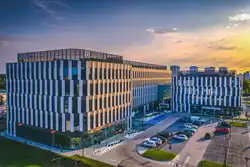Częstochowa is a city with high recognition, which is increasingly clearly marked on the business map of Silesia and Poland. The development of Częstochowa is illustrated by, for example, data on the systematically growing labour market, the decline in unemployment, the development of investments related to the support of business services but also in industry, including automotive and traditional industries: metal processing and glass manufacturing.
There are also large-scale investments in transport infrastructure, both local and connecting Częstochowa with the most crucial communication routes in this area of the country and Europe, i.e. TENT Baltic – Adriatic and the Al motorway running near the city. The strategic location of Częstochowa in the centre of the country, excellent road and rail communication with the most prominent Polish cities and access to a large population – several million people live within a radius of several dozen minutes by car – are some of the primary advantages of this developing city.
Częstochowa, the second-largest Silesian city with over 215,000 inhabitants, is strategically located at the intersection of many transport routes and close to the Katowice-Pyrzowice international airport, which can be reached by car in about 40 minutes. Large-scale investments are being carried out in the city to modernize the road system and public transport or to increase the number of bicycle paths.
Częstochowa has completed the extension of the provincial road No. 908 within the city limits – Monte Cassino Street – and is rebuilding the DK-46 road, which is one of the key Al entrances to the city centre – Główna, Przejazdowa streets and the bypass of sw. Barbara. A large-scale reconstruction of the heavily loaded city fragments of DK-91 is also carried out, which includes the construction of three non-collision intersections -flyovers
says Piotr Grzybowski, Deputy Mayor of Częstochowa. Three integrated transfer nodes were also created, enabling the combination of all public transport means available in the city with individual transportation. The transfer centres will also help to develop and integrate the system of bicycle paths, of which there are currently about 76 kilometres in the city.
The expansion of the transport infrastructure is one of our priorities because we want to take advantage of the fact that 8.5 million people live within a 90-minute drive from Częstochowa. In 2020 alone, we allocated PIN 65 million to the modernization of the road system, out of the total amount ofPLN 155 million invested in the city at that time. The remaining funds were allocated, among others, to the construction of a water park, renovation of the downtown promenade, or thermal modernization of public facilities
Piotr Grzybowski emphasizes.
Częstochowa offers convenient rail connections with the most important urban centres in the country: travel to Warsaw by train takes just over two hours, to Katowice just over an hour and to Wrocław less than two hours. Kraków and Łódź are just an hour and a half away by train. This year, the construction of the new Częstochowa Osobowa Railway Station will also start on the site of the currently functioning building, which will be demolished. PKP S.A. plans to create a facility with various functions (in the area of the new station, there will also be spaces intended for trade and services) with a modern shape adapted to the needs of people with reduced mobility, using modern technologies in the field of safety and ecology. This investment is one of the key projects under the Railway Station Investments Program 2016-2023, which covers over 200 stations throughout Poland. From the point of view of the city and the needs of people visiting Częstochowa, it is a significant investment, which in its new form will be one of the showpieces of a developing, modern urban centre.
The location predestines Częstochowa to develop an office base for business support services – BPO. Arguments for expanding this sector are also educational institutions located in the city and providing qualified staff. In total, nearly 13,000 people study at six universities in Częstochowa, including the Politechnika Częstochowska. These are fields that educate employees desired on the market: over 1,650 people study engineering and technology, nearly 1,000 people study information technology, and over 1,000 people study medical sciences. Architecture and construction are the fields of study that currently educate over 560 people
emphasizes Anna Tymoshenko, Manager of the Investor Assistance Center in Częstochowa.
Czestochowa’s business hub of its heyday is ahead. Improvement of communication infrastructure, including the road system in the city, attractive conditions for investors who want to invest in the city, an extensive and constantly expanding educational base, constant flow of people, growing investments in Częstochowa, locations of the Katowice Special Economic Zone; in which entrepreneurs have already invested over PLN1.7 billion; are just some of the factors determining the growth of this urban centre
says Łukasz Tomczyk, Commercialization Director at DL Invest Group, a Polish investor and developer, which in Częstochowa has completed the DL Jagiellońska l office complex with a usable area of nearly 9,000 square meters offering modern office and commercial space, located on one of the most essential communication arteries in the city -Jagiellońska Street.

In Częstochowa, along with the increase in the wealth of the inhabitants and the development of the city, the demand for modern residential space is also growing. Currently, the most visible are investments in multi-family housing in the Parkitka district. Besides, buildings and housing estates in the terraced, apartment and multi-family housing are also being built in the districts ofLisiniec, Grabówka, Północ, Podjasnogórska, Stradom, Kiedrzyn, Wyczerpy and Raków. The development of residential real estate in the coming years will accelerate both in the city of Częstochowa and in neighbouring locations, which is also possible thanks to the well-developed network of local roads, which opens up several areas located even at a certain distance from cities
summarizes Piotr Grzybowski.
